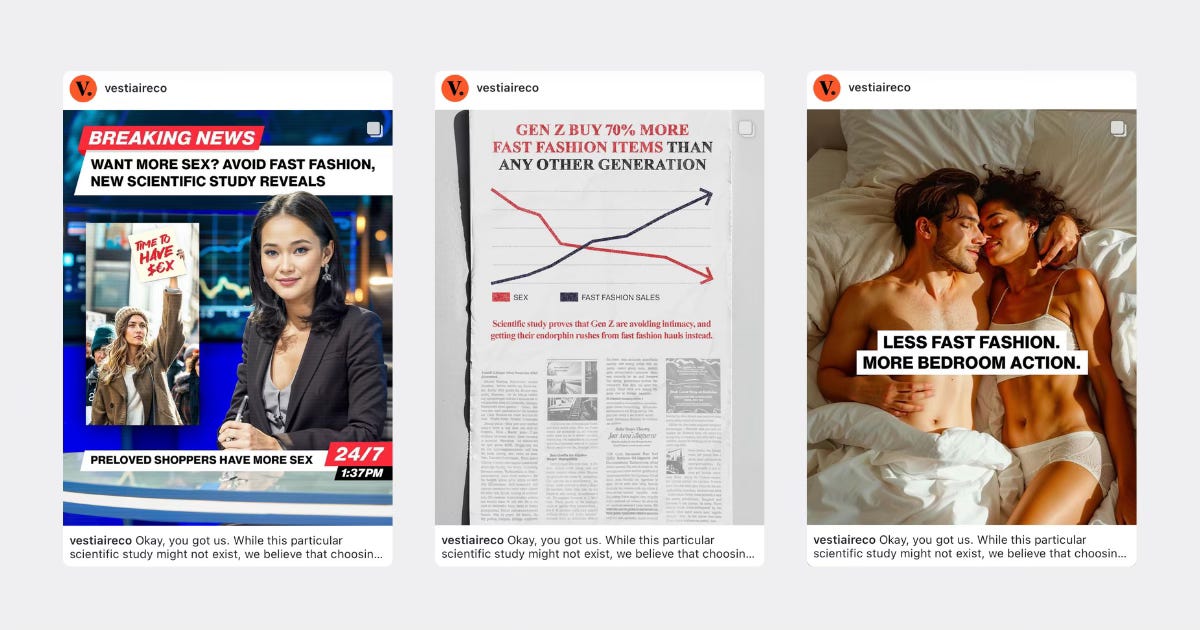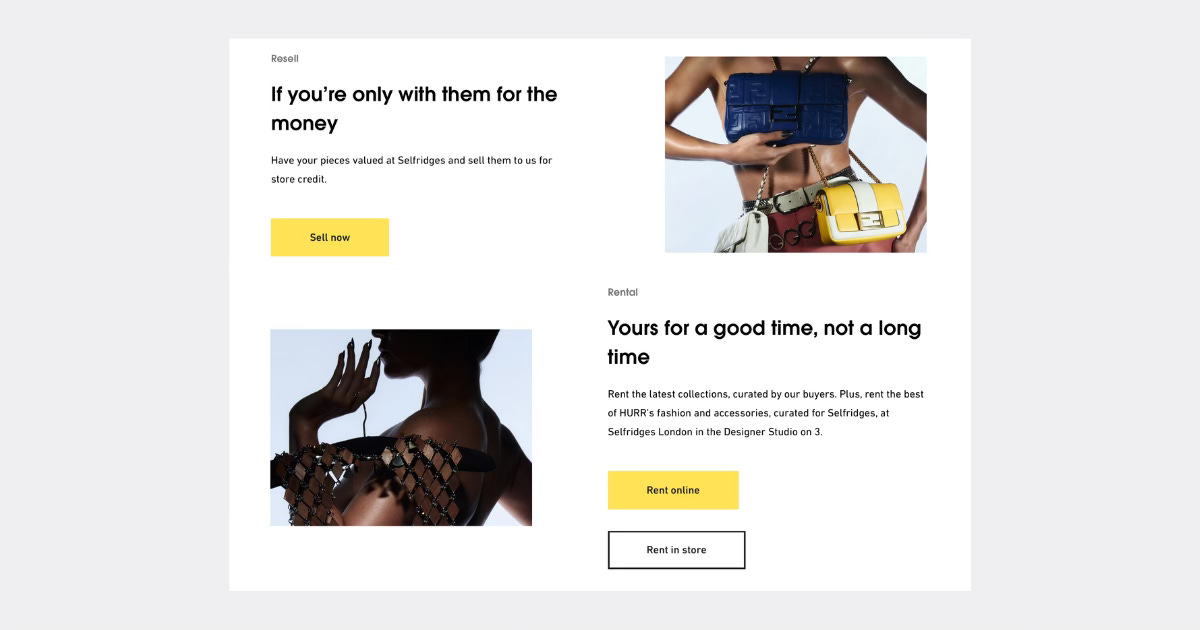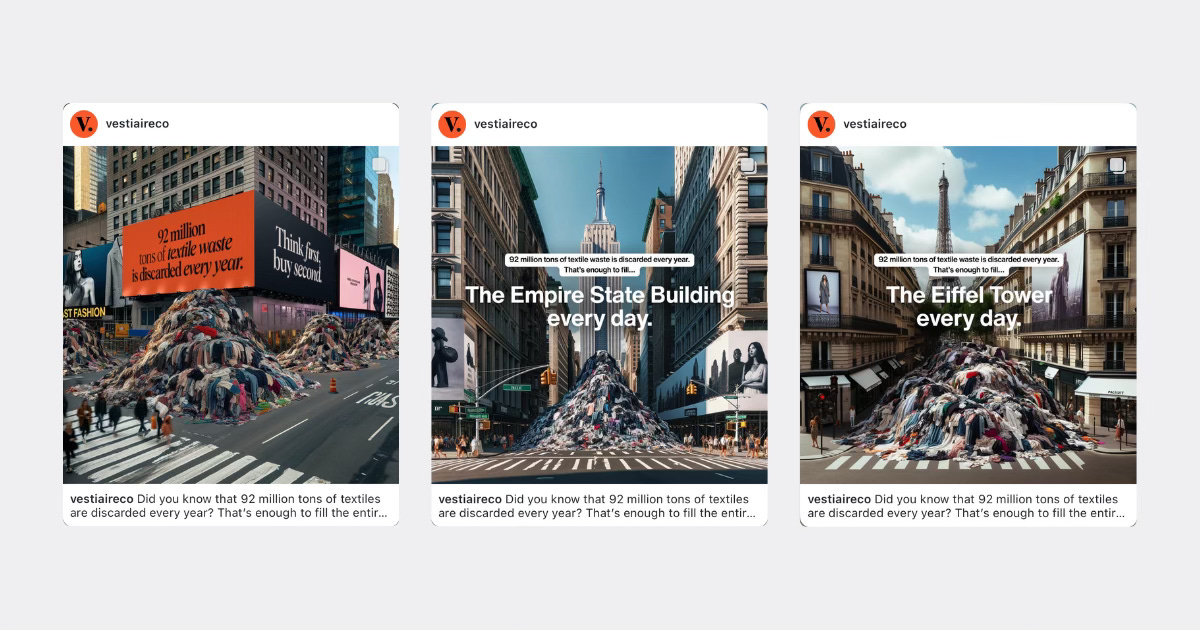Every Brand Talks About Circular Fashion in the Same Predictable (Boring) Way
Selfridges’ new campaign proves that sustainable fashion can be fun, flirty, and anything but boring.
Sustainable fashion is predictable AF.
As consumer demand for sustainability grows, more and more brands and companies are jumping on the sustainability bandwagon. But, instead of bringing fresh ideas to the table, they’re all talking about it in the same boring, predictable way.
Across the board, consumer-facing brands and companies follow a typical sustainability communication strategy. Aside from adjusting their tone and writing style to reflect their target market and audience, when you lay their messaging down side by side, it’s hard to ignore how formulaic and repetitive it all feels.
Take circularity, for example.
Over the past few days, I’ve looked at the websites and social media of major secondhand platforms, from mass market to luxury, as well as tech platforms, repair services, and retailers offering circular solutions.
Across the board, they all seem to follow the same predictable messaging and their language around circular fashion consistently follows a familiar framework and script:
Step One: Highlight the Environmental Problem
Brands emphasize the negative impact of the fashion industry on the planet often using guilt-driven messaging like “fast fashion is killing the planet” or alarming statistics like “X tons of clothing are discarded every second/year.”
Step Two: Position [Fill-in-the-Blank Brand] as the Solution
The brand presents itself as the antidote to the problem, offering sustainable alternatives like resale, repair, or rental. The focus is on how their business model contributes to circularity, with lines like “extend the life of your clothes” or “reduce waste by shopping secondhand.”
Step Three: Emphasize the Scale and Impact
Brands highlight impressive statistics and milestones that showcase their positive impact: “X million items processed,” “X tons of CO2 saved,” or “X gallons of water preserved.”
Step Four: Share Educational Initiatives (if applicable)
Some brands provide tools or resources to educate consumers about sustainable fashion. They also spotlight partnerships to reinforce their commitment to circularity.
Then, they sprinkle in familiar buzzwords and phrases like:
Extend the life of your clothes.
Reduce waste.
Redefine what it means to value our clothes.
Make eco-conscious choices.
Reduce your impact on the planet.
Close the loop.
Old is the new new.
And boom—there’s your circularity messaging.
I get why brands stick to this playbook.
It’s a proven method for communicating sustainability efforts to consumers. It’s also safe. With new laws against greenwashing and growing sensitivity to misleading claims, sticking to predictable communication is less risky and helps brands avoid potential backlash.
But here’s the thing: when you see the same approach over and over, everything starts to blend together and when consumers hear the same messaging again and again, it begins to fade into the background, losing its impact and becoming easy to ignore.
Consumers Need More Than Facts—They Need Emotional Appeal
What’s missing in most of these approaches is the allure that truly draws consumers in. While it may inform and educate, it fails to captivate.
Circular fashion isn’t just about extending the life of clothes or reducing waste—it’s about rethinking our relationship with fashion and making sustainable choices feel as desirable as the incumbent.
People are driven not just by logic but by emotion, particularly by hedonic motivations—the pursuit of pleasure, fun, and social validation.
Fast fashion and overconsumption tap into these motivations by glamorizing newness, affordability, and the thrill of constant consumption. They create a feeling of excitement and instant gratification, offering social proof and signaling status through trendy items.
Fast fashion succeeds because it taps into our desire for status, social belonging, and quick gratification. It creates excitement through novelty and the promise of instant transformation.
In the sustainable fashion space, we often talk about inspiring consumers to make more responsible choices, but the truth is: consumers don’t just need inspiration—they need to be seduced by sustainability, in the same way fast fashion and overconsumption seduce them by tapping into their desire for status, social belonging, and validation.
We need to make sustainability feel as exciting and socially rewarding as fast fashion, but predictable, boring messaging won't cut it. To turn a mission into a movement, we need to offer the same allure and excitement, tapping into consumers' intrinsic wants, needs, and desires through aspiration and creativity.
Sustainability needs to be positioned as aspirational and cool—something consumers want to be part of, not just a responsibility they feel obligated to fulfill.
Without this allure, circular fashion remains a logical but uninspiring choice.
People are moved by social signals, desire, and aspiration—not just statistics. Brands that make sustainability irresistible will not only foster a deeper connection with their audience but will also shift consumer behavior.
How Selfridges is Making Circular Fashion Fun and Desirable

Selfridges’ recent RESELFRIDGES campaign is a brilliant example of what’s possible when sustainability messaging is done right.
The campaign was designed to promote their circular services, which include pre-loved pieces, rental options, repair services, and refillable beauty products. Instead of relying on the typical guilt-driven or logical messaging about the environmental crisis, Selfridges took a fresh and playful approach.
The campaign taps into humor and playfulness—key psychological tools to lower consumer defenses and reduce resistance to new behaviors. Selfridges used cheeky, relationship-themed metaphors like ‘Got a wandering eye?’ and ‘Commitment issues?’ to describe their circular offerings, framing sustainability through the lens of relationships. This injects fun and relatability into the message, making circular fashion feel less like a burdensome obligation and more like an enjoyable, socially desirable choice.
Humor plays an important role here. When consumers laugh or feel entertained, their psychological resistance drops, making them more open to adopting new behaviors. Additionally, humor fosters a positive emotional association with the message, increasing the likelihood of long-term recall and behavior change.
By shifting the focus from sustainability as a duty to sustainability as a source of fun, Selfridges taps into the power of pleasure.
Visually, the campaign is sleek and stylish. The bold, high-fashion aesthetic positions circular fashion as glamorous, desirable, and chic. It reinforces that sustainability isn’t just about responsibility—it’s an aspirational, lifestyle choice.
By using these relationship metaphors, Selfridges appeals to consumers’ emotional attachment to their clothing, encouraging them to repair or resell items rather than discard them when the ‘relationship fades.’ This sentimentality taps into consumers' emotions, making it more likely that they’ll engage in circular fashion practices and embrace sustainability.
Vestiaire Collective is Breaking the Mold Too
Vestiaire Collective is another resale platform that uses the power of creative and provocative messaging to cut through the noise of typical sustainability communication.
Last fall, Vestiaire Collective launched a bold campaign using AI-generated images of famous landmarks like the Empire State Building and the Eiffel Tower with piles of textile waste. These visuals were part of their effort to highlight the staggering volume of clothing discarded every year.
By visually dramatizing the scale of waste, they effectively transformed an abstract, invisible problem into something shockingly tangible. The sight of beloved global landmarks engulfed in discarded clothing strikes an emotional chord, forcing consumers to confront the real-world consequences of overconsumption.
This strategy not only helps break through consumer desensitization to environmental messaging but also taps into a deeper emotional response. By invoking powerful imagery and connecting it to cherished landmarks, Vestiaire Collective triggers a visceral reaction, making the problem of textile waste feel personal and urgent. The campaign also uses the principle of social proof—when consumers see these issues on such a massive scale, they are more likely to feel the collective responsibility to act.
In this way, the campaign elevates the conversation around sustainability from a distant concern to an immediate, emotionally charged issue. It turns an overwhelming statistic—92 million tons of waste—into a visual experience that is impossible to ignore, proving that sustainability messaging doesn't just have to inform, it can also provoke and compel consumers to rethink their habits.

Vestiaire took their creative approach even further with their playful April Fools' Day campaign, humorously claiming that shopping secondhand leads to a more active sex life. The headline declared, “Want more sex? Avoid fast fashion.”
While the faux study was obviously fictional, the underlying message cleverly tied sustainability to personal benefits beyond just helping the environment.
The campaign capitalized on cognitive ease—the idea that when information is presented in a fun, engaging way, it’s more likely to be remembered and acted upon. Positive emotions, like amusement, reduce consumer defensiveness and create an affective halo around the brand. When people feel good, they’re more likely to associate those feelings with the message and act accordingly.
The campaign included tongue-in-cheek visuals like a news anchor announcing the “breaking news” and a graph humorously correlating fast fashion consumption with declining intimacy, complete with the tagline: “Less fast fashion, more bedroom action.”
This playful tone not only made sustainability fun and relatable, but it also managed to break through the typical guilt-driven sustainability messages with humor and a fresh perspective. By using humor to deliver a sustainability message, Vestiaire Collective creates cognitive ease, making the information easier to process, more shareable, and ultimately more memorable.
Brittany, the Resale Industry is a $230 Billion Industry Growing 3X Faster Than Overall Global Apparel Market, Why TF Does Creative Messaging Matter?
It’s true: secondhand fashion is having its moment. Resale platforms are thriving, and consumers are increasingly embracing pre-loved clothing. But here's the thing—just because secondhand fashion is popular doesn't mean these platforms can afford to be boring. In fact, in an ever-growing market, how you communicate about circular fashion matters more than ever.
As more platforms and retailers offering circular solutions enter the space, the competition is becoming increasingly fierce.
Sticking to the same predictable sustainability messaging risks blending into the noise. Sure, people are already shopping secondhand, but that doesn’t mean they’re building an emotional connection with these platforms —or that they’ll stay loyal. This is where creative, engaging communication becomes a critical differentiator.
Another reason creative messaging matters: brand loyalty and long-term engagement. While consumers might be turning to secondhand shopping, those who connect emotionally with a platform or service are far more likely to stick with it, advocate for it, and share their experiences.
Platforms that can make circularity and sustainability feel cool, aspirational, and part of a larger lifestyle narrative will build lasting loyalty in an increasingly crowded market.
This applies to more than just resale platforms. While secondhand shopping is booming, rental and repair services haven’t caught on to the same extent. But they could.
Creative messaging can make rental and repair services feel just as aspirational as resale, helping consumers see the value in these circular solutions as well to push the next big shift in fashion.
But if you’re still not convinced, consumer fatigue is real and something to keep in mind.
With circular fashion now a buzzword, consumers are bombarded with repetitive, predictable messaging.
How you talk about circularity and sustainability is just as important as the solutions you offer.
Even as secondhand platforms and circular services thrive, those that innovate their messaging—making it fun, engaging, and emotionally resonant—will stand out, build stronger consumer connections, and lead the charge as the circular economy continues to evolve.
Lessons for the Industry
We can learn a lot from Selfridges' #RESELFRIDGES campaign and Vestiaire Collective's bold messaging. Both companies show how sustainability messaging can break free from the usual script and actually connect with consumers on a deeper, emotional level.
01. Move Beyond Guilt-Driven Narratives—But Know When to Use It Effectively:
Positive reinforcement often works better than guilt in driving long-term behavior change. When sustainability is linked to pleasure and self-empowerment, consumers are more likely to take action. Many sustainability campaigns rely on guilt as a motivator, bombarding consumers with statistics about waste and environmental harm. While guilt can create awareness, it often leads to emotional fatigue or defensiveness, causing consumers to tune out.
However, there are moments when guilt, if used creatively and with emotional resonance, can break through consumer desensitization. Vestiaire Collective’s AI campaign is a prime example. It used guilt in a powerful, visceral way, making the scale of fashion waste feel personal and urgent. But Vestiaire balanced this with a clear call to action, ensuring the guilt motivated change rather than sparking defensiveness.
The lesson? Use guilt sparingly and with impact, but know when to pivot toward positive reinforcement to keep consumers motivated and inspired.
02. Reframe Sustainability as Fashionable and Aspirational
The desire to belong to a cool, aspirational community can motivate consumer behavior far more effectively than an ethical appeal. Fast fashion has mastered this by creating desire through visually appealing campaigns, influencer endorsements, and leveraging social media to tap into the need for social validation. People often buy into a lifestyle or identity more than the product itself, making this approach particularly powerful.
Fast fashion taps into lifestyle aspirations, creating excitement and desirability through fashion-forward imagery. This is where sustainable fashion has often struggled. The challenge for sustainable brands is to break free from outdated stereotypes and prove that sustainability can be stylish, sleek, and cutting-edge.
Selfridges understood this with its #RESELFRIDGES campaign, using sleek, moody imagery to rebrand circular fashion as chic and high-fashion. By positioning sustainability as aspirational and cool rather than simply responsible, they’ve demonstrated that circular fashion can be part of an exciting, fashion-forward lifestyle.
03. Inject Creativity into the Language:
Consumers are constantly bombarded with the same buzzwords. While these phrases communicate important ideas, their repetition has diluted their impact.
When brands use language in unexpected ways, it stands out in a crowded marketplace and taps into a deeper psychological response. Consumers are more likely to engage with and remember a message that makes them think or laugh. This creative use of language also makes the message feel fresh and approachable, helping to dispel any notion that sustainability is a dry or inaccessible topic.
Additionally, creative language invites participation. It makes consumers feel like they’re in on the joke or part of a cultural moment, creating a sense of belonging and shared values. By incorporating playful and innovative language, brands can make sustainability feel fun, engaging, and something consumers want to talk about.
A Lesson for the Road
Selfridges and Vestiaire Collective prove that sustainability messaging doesn’t have to be dry or repetitive. By embracing creativity, humor, and emotional resonance, these brands demonstrate how to inspire consumers to make lasting, impactful changes.
Both companies effectively leverage key psychological principles—such as loss aversion, sentimentality, and cognitive ease—to make sustainability feel relatable and enjoyable. Their strategies offer a powerful blueprint for how brands can connect with consumers on a deeper emotional level, transforming eco-conscious choices into something aspirational rather than obligatory.
It's a wake-up call for other brands: sustainability can be fun, chic, and exciting, but only if we break free from predictable narratives and rethink how we communicate it.
🤓🧠 BS
Enjoyed this post? Here are a few ways you can support me and my work:
→ Share this post with a friend, colleague or someone who would find value from reading it.
→ Heart or comment on this post, it helps others find my writing.?
→ Become a paid subscriber












And it’s not just brands. It’s sustainability ‘experts’ too
OMG I’ve been having the same conversation with a friend about this for weeks. The same rhetoric dragged out all the time. Nothing different, nothing compelling. I need to share this post somehow. So well said.